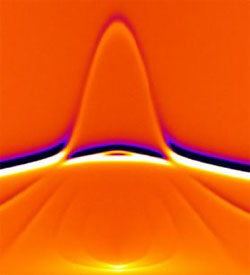The National Applied Research Laboratories will open branches on nanotechnology and chip design at National Chengkung University in southern Taiwan later this week, a university spokesman said yesterday.
Oct 2nd, 2007
Read more
Up to $240,000 in savings bonds will be awarded this year to student winners whose innovative ideas combine imagination with the tools of science.
Oct 1st, 2007
Read more
Engineers have shown how to grow forests of tiny cylinders called carbon nanotubes onto the surfaces of computer chips to enhance the flow of heat at a critical point where the chips connect to cooling devices called heat sinks.
Oct 1st, 2007
Read more
UC Irvine's Henry Samueli School of Engineering has been awarded $2.18 million to blend traditional DNA sequencing techniques with cutting-edge nanotechnology to develop a faster and less costly method of analysis.
Oct 1st, 2007
Read more
Internationally recognized experts will present recent achievements in molecular diagnostics based on nanotechnological tools. These principles will open the door to personal diagnosis and therapy but also to bio-electronic circuitry.
Oct 1st, 2007
Read more
On the 50th anniversary of the launch of Sputnik, former Harvard Business School professor John Kao describes the U.S. as fat and complacent, and gives the nation a failing report card on how it stacks up in innovation capacity compared to other countries.
Oct 1st, 2007
Read more
An interesting paper about nanotechnology regulation - Nanotechnology Bound: Evaluating the Case for More Regulation - by Patrick Lin of The Nanoethics Group has been posted over at their website.
Oct 1st, 2007
Read more
The Nanoethics Group announced today that that it has been invited by Yale University�??s Technology and Ethics Working Group to deliver a public lecture on nanoethics next week at the university.
Oct 1st, 2007
Read more
The White House is now seeking to place its stamp on federal scientific spending during the Bush administration�??s final year in office, according to a memo released last Friday by Public Employees for Environmental Responsibility.
Sep 30th, 2007
Read more
Possible advances for nanoscience, energy, biology, and materials research.
Sep 28th, 2007
Read more
In the global race for possibilities for the use of electron spin, an international research team is right at the forefront: The researchers have managed to maintain the polarisation of nuclear spin and its associated electron spin for some ten minutes - a virtually endless amount of time for typical computer calculation steps.
Sep 28th, 2007
Read more
The iBIO Institute today announces two local individuals as its first iCON Award winners. Professor Chad A. Mirkin is honored with the Institute's 2007 "iCON Innovator" award.
Sep 28th, 2007
Read more
 Materials researchers have pushed the measurement of thin films to the edge - literally - to produce the first data on how the edges of metallic thin films contribute to their magnetic properties.
Materials researchers have pushed the measurement of thin films to the edge - literally - to produce the first data on how the edges of metallic thin films contribute to their magnetic properties.
Sep 28th, 2007
Read more
A workshop on nanomaterials and gender aspects in research and technology will be held in Gothenburg, Sweden, on October 18 and 19, 2007.
Sep 27th, 2007
Read more
New technology enables real-time diagnostics and on-site repair.
Sep 27th, 2007
Read more
A novel device simply and conveniently traps, detects and manipulates the single spin of an electron, overcoming some major obstacles that have prevented progress toward spintronics and spin-based quantum computing.
Sep 27th, 2007
Read more


 Subscribe to our Nanotechnology News feed
Subscribe to our Nanotechnology News feed